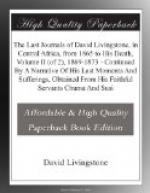29th September, 1869.—I visited a hot fountain, an hour west of our camp, which has five eyes, temperature 150 deg., slightly saline taste, and steam issues constantly. It is called Kasugwe Colambu. Earthquakes are well known, and to the Manyuema they seem to come from the east to west; pots rattle and fowls cackle on these occasions.
2nd October, 1869.—A rhinoceros was shot, and party sent off to the River Luamo to buy ivory.
5th October, 1869.—An elephant was killed, and the entire population went off to get meat, which was given freely at first, but after it was known how eagerly the Manyuema sought it, six or eight goats were demanded for a carcase and given.
9th October, 1869.—The rite of circumcision is general among all the Manyuema; it is performed on the young. If a headman’s son is to be operated on, it is tried on a slave first; certain times of the year are unpropitious, as during a drought for instance; but having by this experiment ascertained the proper time, they go into the forest, beat drums, and feast as elsewhere: contrary to all African custom they are not ashamed to speak about the rite, even before women.
Two very fine young men came to visit me to-day. After putting several preparatory inquiries as to where our country lay, &c., they asked whether people died with us, and where they went to after death. “Who kills them?” “Have you no charm (Buanga) against death?” It is not necessary to answer such questions save in a land never visited by strangers. Both had the “organs of intelligence” largely developed. I told them that we prayed to the Great Father, “Mulungu,” and He hears us all; they thought this to be natural.
14th October, 1869.—An elephant killed was of the small variety, and only 5 feet 8 inches high at the withers. The forefoot was in circumference 3 feet 9 inches, which doubled gives 7 feet 6 inches; this shows a deviation from the usual rule “twice round the forefoot = the height of the animal.” Heart 1-1/2 foot long, tusks 6 feet 8 inches in length.
15th October, 1869.—Fever better, and thankful. Very cold and rainy.
18th October, 1869.—Our Hassani returned from Moene Kirumbo’s; then one of Dugumbe’s party (also called Hassani) seized ten goats and ten slaves before leaving, though great kindness had been shown: this is genuine Suaheli or Nigger-Moslem tactics—four of his people were killed in revenge.
A whole regiment of Soldier ants in my hut were put into a panic by a detachment of Driver ants called Sirufu. The Chungu or black soldiers rushed out with their eggs and young, putting them down and running for more. A dozen Sirafu pitched on one Chungu and killed him. The Chungu made new quarters for themselves. When the white ants cast off their colony of winged emigrants a canopy is erected like an umbrella over the ant-hill. As soon as the ants fly against the roof they tumble down in a shower and their wings instantly become detached from their bodies. They are then helpless, and are swept up in baskets to be fried, when they make a very palatable food.




